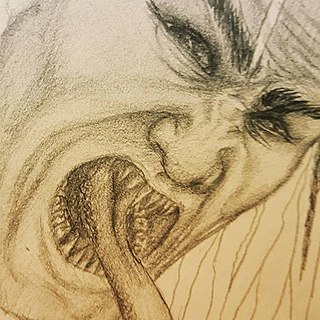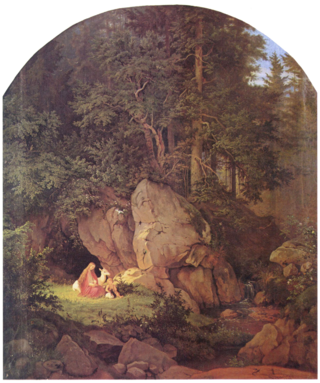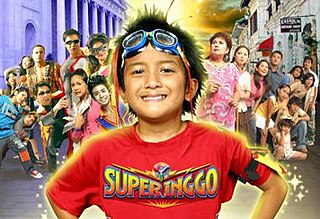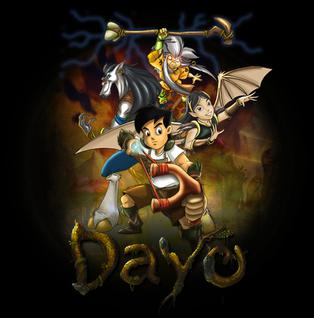
In mythology, folklore and speculative fiction, shapeshifting is the ability to physically transform oneself through unnatural means. The idea of shapeshifting is in the oldest forms of totemism and shamanism, as well as the oldest existent literature and epic poems such as the Epic of Gilgamesh and the Iliad. The concept remains a common literary device in modern fantasy, children's literature and popular culture.

The Black Knight is the alias of several fictional characters appearing in American comic books published by Marvel Comics.

Aswang is an umbrella term for various shape-shifting evil creatures in Filipino folklore, such as vampires, ghouls, witches, viscera suckers, and transforming human-beast hybrids. The aswang is the subject of a wide variety of myths, stories, arts, and films, as it is well known throughout the Philippines. Spanish colonists noted that the aswang was the most feared among the mythical creatures of the Philippines, even in the 16th century. Although with no specific motive other than harming others, their behavior can be interpreted as an inversion of the traditional Filipino's values. The aswang is especially popular in southern parts of Luzon, and some parts of Mindanao and Visayas, especially the Visayan province of Capiz.

Philippine mythology is rooted in the many indigenous Philippine folk religions. Philippine mythology exhibits influence from Hindu, Muslim, Buddhist, and Christian traditions.

Undines are a category of elemental beings associated with water, stemming from the alchemical writings of Paracelsus. Later writers developed the undine into a water nymph in its own right, and it continues to live in modern literature and art through such adaptations as Danish Hans Christian Andersen's 1837 "The Little Mermaid" and the 1811 novella Undine by Friedrich de la Motte Fouqué.
Pedro Penduko is a Filipino fictional comic book character created by National Artist for Literature Francisco V. Coching. The character, who is styled as a folk hero, debuted in the magazine Liwayway in 1954.

Queen of Fables is a supervillain who has battled the Justice League, Wonder Woman and Superman. Based on the character of the Evil Queen from "Snow White", the Queen of Fables is the living embodiment of all evil in folklore. She first appeared in JLA #47, and was created by Gail Simone, Mark Waid and Bryan Hitch.

Da Adventures of Pedro Penduko is the third and fourth season of the Philippine fantasy TV series Komiks. The third season began airing in the Philippines on September 9, 2006, and ended on April 28, 2007, on the ABS-CBN.

The Bakunawa is a serpent-like dragon in Philippine mythology. It is believed to be the cause of eclipses, earthquakes, rains, and wind. The movements of the Bakunawa served as a geomantic calendar system for ancient Filipinos and were part of the rituals of the babaylan priestess. It is usually depicted with a characteristic looped tail and a single horn on the nose. It was generally believed to be a sea serpent, but is also variously believed to inhabit either the sky or the underworld.

In folklore and fantasy, an enchanted forest is a forest under, or containing, enchantments. Such forests are described in the oldest folklore from regions where forests are common, and occur throughout the centuries to modern works of fantasy. They represent places unknown to the characters, and situations of liminality and transformation. The forest can feature as a place of threatening danger, or one of refuge, or a chance at adventure.

Pedro Penduko at ang Mga Engkantao is the fifth season of Komiks. and is the second installment of the Pedro Penduko comics series. In this story, Pedro will not be the only one who will fight the evil Kalagua. He would be with the five chosen "Engkantao".

Super Inggo is a Philippine fantaserye aired on ABS-CBN. Its main character is Budong, a 10-year-old kid who dreams of becoming a real-life and full-fledged superhero. Unbeknownst to him, he possesses superhuman strength and abilities which he inherited from his Superhero father and Villain mother.
Mythic humanoids are legendary, folkloric, or mythological creatures that are part human, or that resemble humans through appearance or character. Each culture has different mythical creatures that come from many different origins, and many of these creatures are humanoids. They are often able to talk and in many stories they guide the hero on their journey.

Dayo: Sa Mundo ng Elementalia also called Niko: The Journey to Magika in English-speaking countries, is a 2008 animated adventure-fantasy comedy film and the Philippines' first all-digital full-length animated feature film. Produced by Cutting Edge Productions, the film revolves around Bubuy who has to save his grandparents who were abducted and brought to the strange land called Elementalia, home to a host of strange creatures from Philippine mythology. This $1.3 million production composed of over 500 local animators features a “tra-digital animation” technique using paperless 2D and 3D technologies. It has 2D animation for its characters and 3D animation for the backdrops.
Thep Sarm Rudoo (Thai: เทพสามฤดู; RTGS: Thep Sam Ruedu) is a 2005 Thai lakorn boran (Classic Play) based on Thai folklore which has been remade several times. This Thai television soap opera is one of the most popular in Thailand at 2005 with many famous actors and actress as the beautiful couple for Thai lakorn boran's fan. The plot is about a child of a king who can turn into 3 incarnations by changing season like turning to man for rainy season, turn to woman for cold season and turn to giant for dry season.

Aso ni San Roque is a Philippine television drama fantasy series broadcast by GMA Network. Directed by Don Michael Perez, it stars Mona Louise Rey. It premiered on September 10, 2012, on the network's Telebabad line up replacing Makapiling Kang Muli. The series concluded on January 11, 2013, with a total of 90 episodes. It was replaced by Indio in its timeslot.












